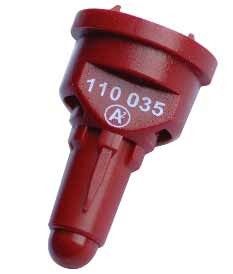Some Aspects of Designing and Developing Higher Performing Hydraulic nozzles for Ground Crop Sprayers in the UK
Personal involvement in application research prior to developing higher performing nozzles
For over 20 years as Application Specialist for Ciba-Geigy UK Ltd, a significant part of my job included field trials with Ciba-Geigy products applied with novel application techniques supplied by equipment manufacturers. If the new technique showed some advantage and was at least as effective as the standard, typically 200 l/ha at 6 km/h via a 110 degree fan jet operating at c. 2 bar pressure, then I would recommend the new technique for UK farmers who wished to use it, and the product/application technique combination would be supported by Ciba-Geigy. Key elements to these trials were that the application would be done in conjunction with the equipment manufacturer, using crop protection products, in the field, at current farm forward speeds. In time, it became normal to include a tracer dye with the spray, so that one could measure the effect of application technique on the quantity and location of the spray deposits. The trials were assessed for product efficacy in the normal way, including % control and yield. From these trials, Ciba-Geigy was able to offer farmers safer and more effective application recommendations including (to name some of the output of the application trials): rotary atomiser controlled droplet applications (CDA); herbicide applications of herbicides at 20 l/ha; low volume hydraulic applications of most products in the range at 100 l/ha; twin-fluid (Airtec) applications at 80 l/ha; low volume air assisted applications; and reduced drift applications with pre-orifice; and air inclusion nozzles.
External influences in application research
Students of spraying are well aware that all hydraulic nozzles produce a range of drop sizes, and that big drops contain much more liquid than small drops. When drop diameter is doubled, the volume increases by a factor of 8. If one can control drop size then one can get high drop numbers in a useful size range, at low volumes
During the late 70s and early 80s, the imagination was caught by CDA sprayers, which offered the opportunity to ‘dial a drop size’. Liquid fed in a controlled manner onto the centre of a spinning disc, is emitted at the perimeter as uniform sized drops, the size of which is dependent on the speed of rotation of the disc. The faster the speed, the smaller the drops. Because one can control the drop size, it was possible to achieve good coverage with 30+ drops/cm at volumes as low as 10 l/ha. CDA sprayers defined much of the still current thinking on spray physics. The majority of atomizers rotated in the horizontal plane, so the emitted drops were entirely dependent on gravity and air movement for their fate. In a cereal crop, fine drops (100 µm) with a low terminal velocity were deemed to stay high in the canopy, and be good for fungicides and insecticides, while coarse drops (250 µm), would fall vertically and penetrate deep into the canopy, and be suitable for herbicides. In between were medium sized drops (175 µm).
In 1986, there was a significant change in pesticide regulation in the UK, and this coincided with the inclusion the BCPC spray quality classification for hydraulic nozzles on chemical labels. This classification was based loosely on the coarse medium and fine sprays produced by rotary atomisers, the big difference being that coarse medium or fine, when applied to hydraulic nozzles, is based on the volume median diameter (v.m.d.), and each classification has a band of v.m.d. sizes. There is another crucial difference: spray from a hydraulic nozzle on a boom sprayer fires downwards under its own energy, while drops from a rotary atomiser accelerate under gravity up to their terminal velocity. Drops from a hydraulic nozzle slow down to their terminal velocity via drag. This means that the association of drop size and behaviour is not universal to all application techniques. Laboratory work (Lake & Taylor) on mono sized drops on greenhouse grown barley plants, showed that 100 µm drops were well retained, and drops above 200 µm were poorly retained. This led to a belief that large drops were bad, as they gave poor coverage, and were poorly retained. This belief is largely still ingrained in the industry, and is further re-inforced by standard wording on product labels: ‘Apply the product in 200 l/ha as a medium quality spray according to the BCPC code’. An agronomist writing a recommendation for a farmer, will use this, as he knows the chemical manufacturer will stand by it if for whatever reason the product underperforms.
This is an extract of the full article published in: Outlooks on Pest Management – August 2015 issue.
The full text of this article is available to subscribers of Outlooks on Pest Management.
Non-subcribers may buy & download full text article.
Author: T.H. Robinson – explains the philosophy behind the improvements in hydraulic nozzles
Category: Agriculture












